Email Marketing for Nonprofits: The Essential Guide!
As an employee of a nonprofit, chances are you have a huge stack of tasks. You are doing many more things than you have time for, and are trying your best to fundraise and thank your donors.
If this describes you, then email marketing might be the most effective (and accessible) marketing tactic that NPOs (Nonprofit Organizations) can put their effort towards.
Email marketing is certainly far from dead - and this is especially true in the NPO marketing world, where personalized messaging and relationship building are keys to success. Additionally, building an email strategy is often less expensive and time-consuming than other strategies.
So, in this post, you will find out how your nonprofit can bring in new prospects through email marketing and stay connected with donors.
Let’s get started!
What is email marketing for nonprofits?
Not so different from the traditional email marketing used in the for-profit sector, email marketing for nonprofits is a digital strategy centered on using emails to:
- Develop and maintain relationships with prospects and existing supporters
- Convert one-time donors into long-term donors.
- Drive more donating activities and other actions related to your mission.

You can send monthly newsletters to your donor base, keeping them in the loop on the impact their donations are making. You can also ensure that every donor who gives through your website immediately receives a “thank you” note as soon as the transaction is complete. Email marketing campaigns are also the perfect way to update your audience about new initiatives, new programs, and upcoming events.
Why does email marketing work for nonprofits?
A robust nonprofit email marketing strategy helps organizations raise brand awareness, communicate with their audience effectively, expand their donor base, acquire and cultivate supporters, and ultimately develop long-term relationships.
The good news is: many donors prefer email.
In a study conducted by Campaign Monitor, 42% of donors said that they prefer to hear via email from a nonprofit, and 20.5% believed that an email from the nonprofit would inspire them to give again.
Furthermore, according to M+R’s 2020 Benchmark Study, the average email open rate from the nonprofit sector is 17%, with remarkable increases in open rates for advocacy and fundraising emails. Email marketing, especially when strategically integrated with other channels, can be an influential force in securing donations.
Below are some untenable benefits of email marketing for your nonprofit:
-
Reach more people. Most nonprofits don’t have the resources for mainstream media ads. With email marketing campaigns, they can reach more people at scale.
-
Send more targeted and relevant messages. Cold calling and “spray and pray” snail mail campaigns are actually a thing of the past. Targeted email marketing campaigns enable your profit to benefit from technology that identifies ideal donors. Opening doors to communicate with these donors helps align their goals with yours for long-term partnerships.
-
Maintain regular, top-of-mind awareness. Email automation and drip campaigns allow you to stick to a predetermined schedule of donor touchpoints while scaling resources. Connecting regularly with your audience will keep your mission and organization top-of-mind.
-
Deepen trust with your audience. Maintaining continuous communication creates familiarity and trust. These two factors help build engagement, and ultimately, donations.
11 different types of nonprofit email marketing
Below, we break down 11 nonprofit email marketing types that any organization can use as part of their next campaign.
1. Welcome emails
Whenever you get new email subscribers, it’s imperative you give them a warm welcome. Welcome emails not only help you put your best foot forward, but also increase your chances of getting donations down the line.
Studies show that welcome emails boast 4 times higher open rates and 5 times higher click-through rates than traditional emails. What’s most remarkable for nonprofits is that welcome emails can result in 8 times the transaction rate of a promo email. In that light, your welcome emails are crucial in securing donations.
Let’s take a look at this welcome email from Save the Children. It accomplishes four things necessary for a compelling welcome series:
- Personalizes the email by mentioning recipient’s name
- Sets a positive tone
- Provides expectations for what recipients can look forward to in the future
- Highlights the value of the organization
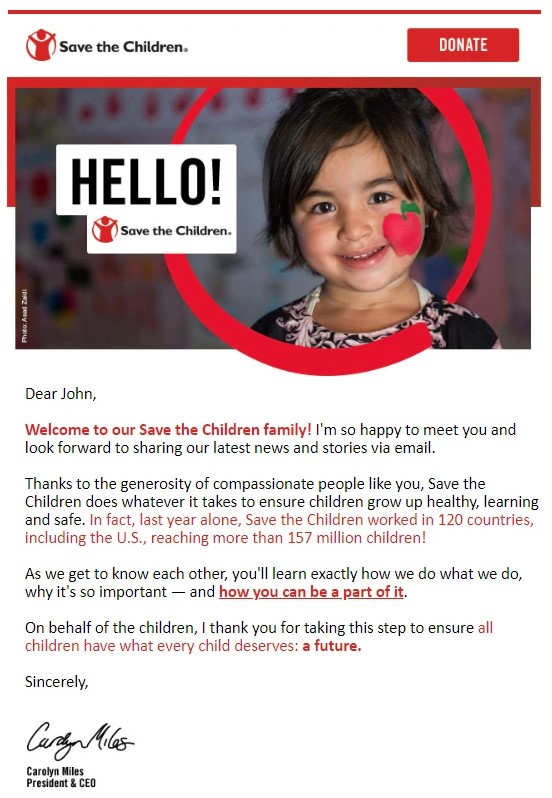
2. Storytelling emails
No matter what your root cause might be, stories play a central part in your nonprofit email marketing strategy as they can draw readers in emotionally. This approach will make people more psychologically inclined to donate.
You should not try to box yourself into thinking of a story only in terms of text. Instead, you can use photos to tell a compelling and emotional story.
This email from WWF (World Wildlife Fund) is a shining example of combining imagery with compelling copy.
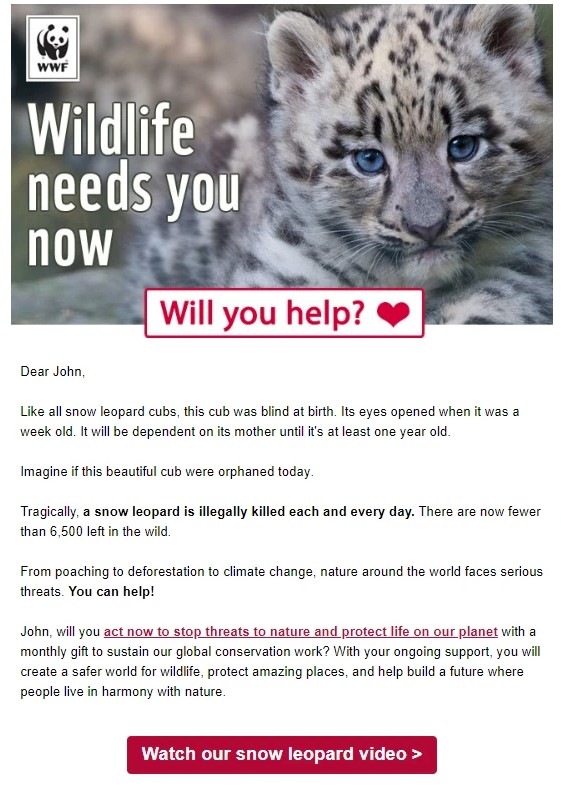
The very first thing you see is a large, striking photo of a snow leopard looking straight at you, which makes an instant connection (particularly given that some of us are actually wired to care as much about animals as people). Next, by addressing the recipient by name and asking a direct question, the message starts and ends on an emotional note, supported by talking statistics on the mistreatment of leopards.
If you’re running a blog, storytelling emails are an excellent way to encourage your recipients to read your latest post and ideally, donate. You can see how the St. Baldrick’s Foundation does it:
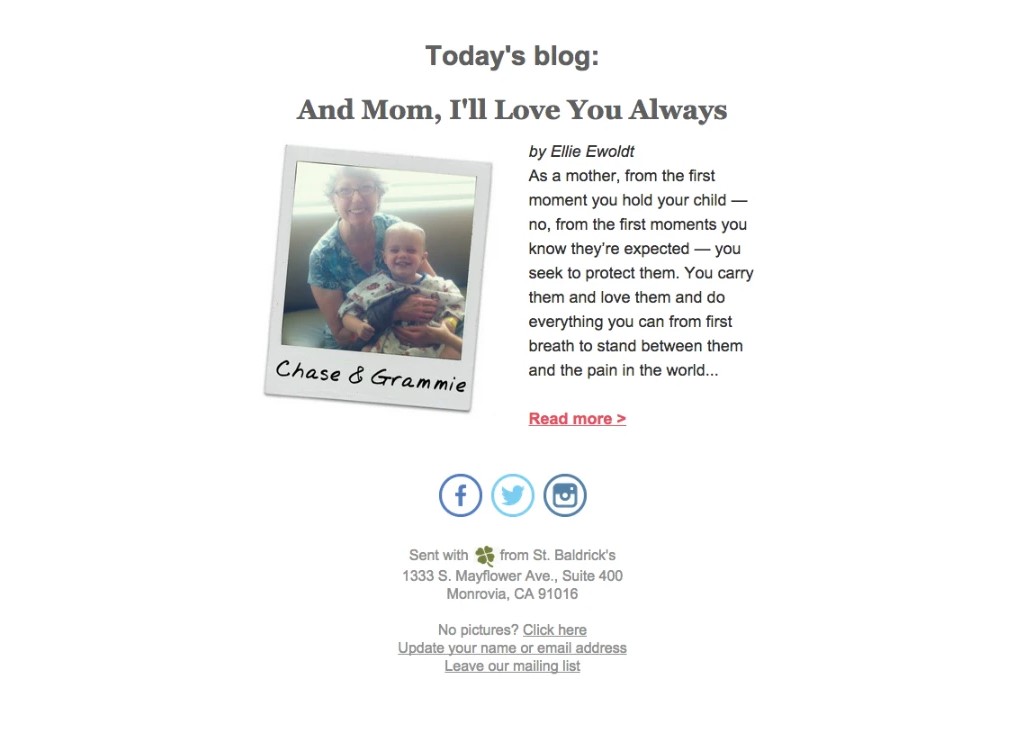
3. “Success Story” emails
Don’t forget to provide your donors with stories of your organization’s success and how they have contributed. By highlighting specific success stories or instances of someone benefiting from your nonprofit, you can provide concrete proof of your organization’s impact.
In a day and age where up to one-third of Americans are skeptical of charitable organizations, that kind of proof really matters.
For example, this email from charity: water highlights an actual instance of donations in action by delivering the story of Srey and her family in Cambodia. Showing off Srey and her new water filter serve as firm proof that donations are doing legitimate good.
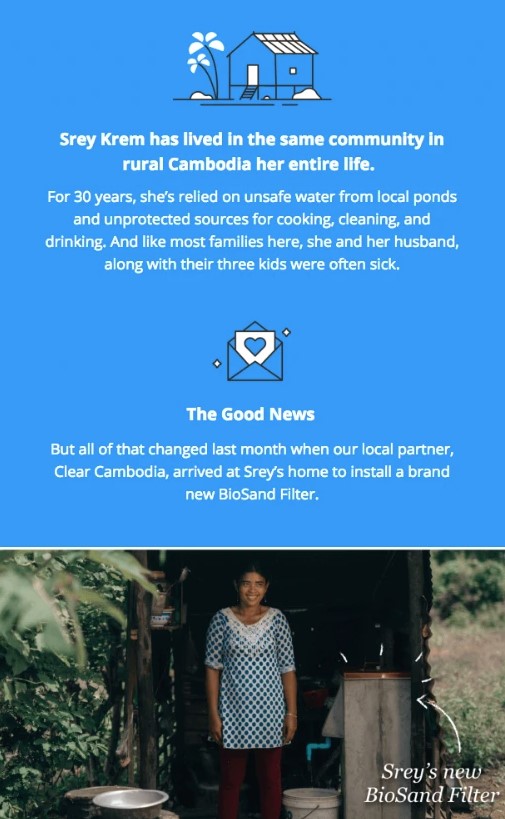
Sticking to the gold principle of “show, don’t tell,” social proof is proven to boost email engagement. Whether it’s testimonials, smiling faces, or stats from a fundraising goal, showcase the broader community that has contributed to your case and make your audience feel proud to be a part of it.
4. “Thank You” and update emails
There’s one thing that all seasoned fundraisers can agree on: showing appreciation is essential to maintaining relationships with donors.
Saying thank you and showing them the impact of their gifts motivates them to keep giving, and to spread the word about the excellent work your organization is doing. This is especially important right after a donation is made.
Additionally, by opting in to your emails, recipients signal that they really want to be kept in the loop. Providing important updates keeps these supporters engaged with your organization and coming back to donate again and again.
Some ideas that can be used in your update emails include:
- Significant milestones for your nonprofit, like helping a specific number of people or raising a certain amount of money
- Celebrating your organization’s anniversary
- New campaigns, programs, or initiatives your nonprofit organization is rolling out
This progress update email from charity: water is an example of an update email inaction. It highlights specifics like where the donation is going, how many projects have been fundraised so far, and how close the project is toward reaching its goal.
By doing so, they can create a feel-good moment for their subscribers. Small touches like the “You are here” marker in the timeline make donations in question seem more tangible.
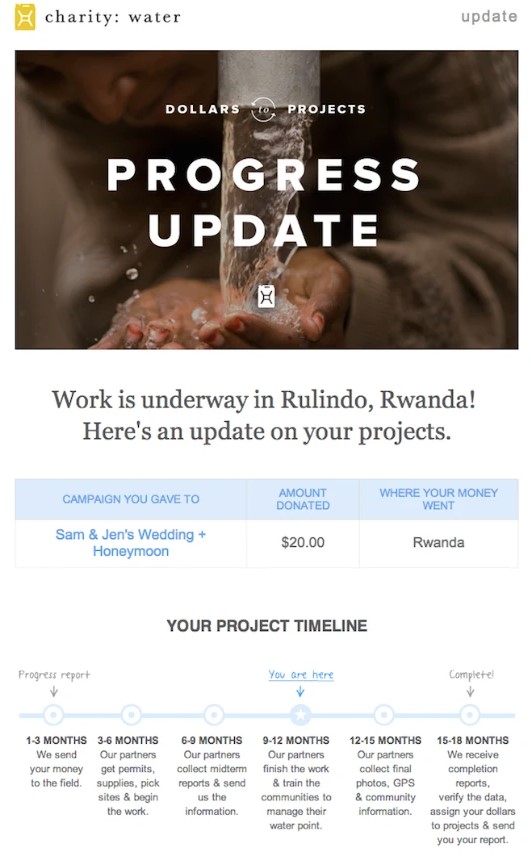
Framing these sorts of updates as “thank you” can help increase opens and click-throughs.
As a matter of fact, “thank you” emails have an average engagement rate of 62%. Plus, “thank you” emails receive double the click-through rate of any other type of message.
5. Significant day emails
In addition to making sure that your emails provide updates about your organization, you also want to include relevant and timely content in a broader sense.
In today’s world, there is a special day to celebrate just about anything, so find a significant day that ties well to your organization’s mission and leverage it to engage your audience.
You can put together content inspired by the day you are celebrating or offer resources to your recipients about how they can get involved.
Take a look at how Pencils of Promise celebrated Mother’s Day via its email marketing campaign:
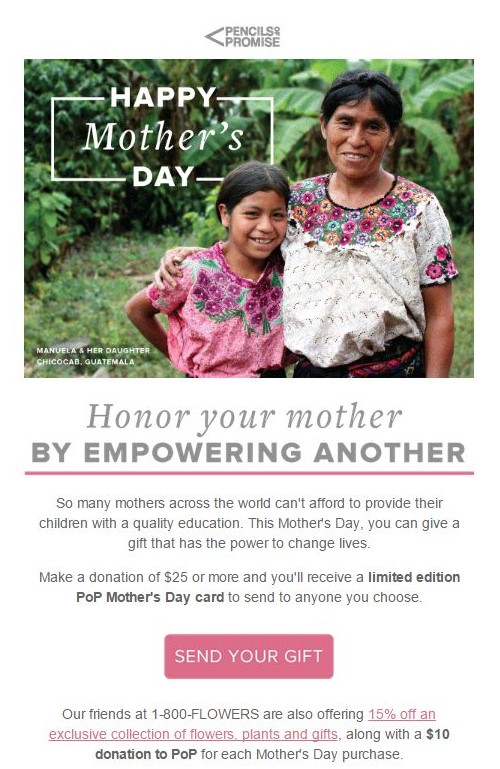
Don’t be afraid to push for significant days because people expect it, and they are ready to answer the call.
6. Newsletters: update and educate
One of the most typical types of nonprofit email is a good newsletter. These are structured to raise awareness on a particular issue, provide resources, and update readers on activities going on in the organization.
As this is the most common and recurring nonprofit email type, you can save yourself some time by creating a template that will allow you to roll these out regularly.
That may include a branded header or hero image, together with text and photo blocks that you can update easily - and remember, simple is the way to go!
Need inspiration? Check out this email from WWF!
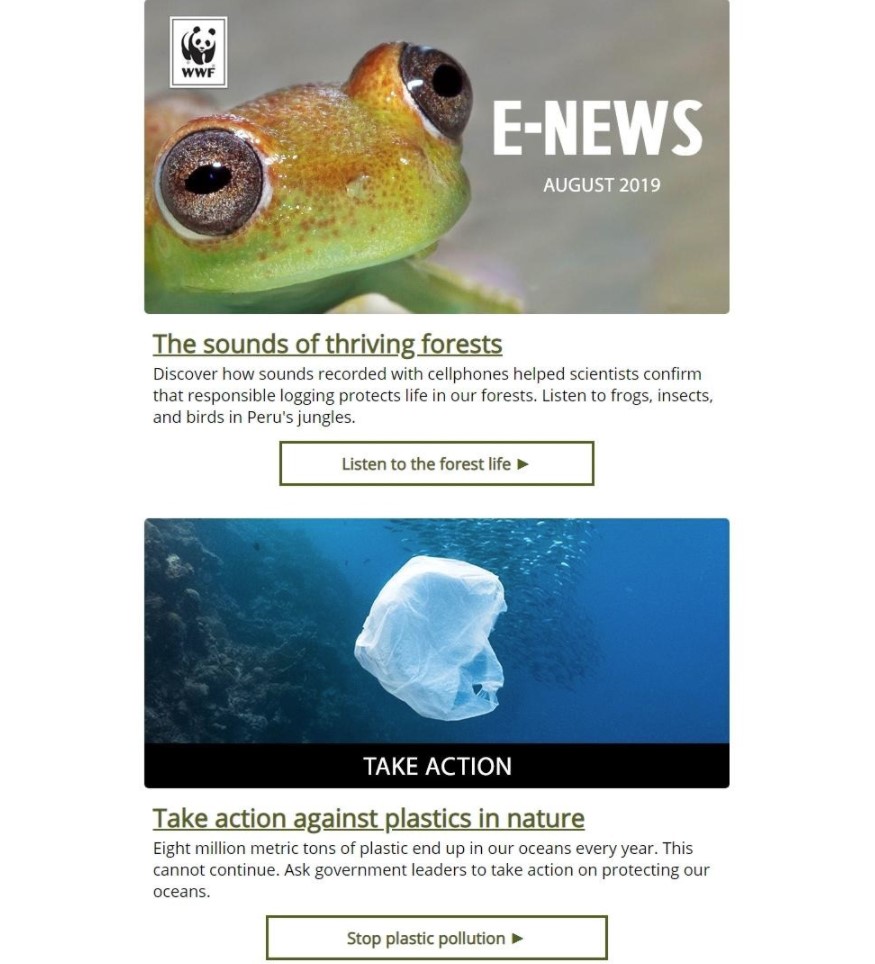
This newsletter is packed full of news that an environmentalist would love to read. At the same time, it is designed in a way that is not overwhelming, including simple images, short but informative headings, as well as links to read more.
7. Number and statistic-based emails
Standing out in your recipient’s inbox can be an uphill battle, but numbers and statistics in your email subject lines are a way you can immediately grab their attention. Below are some examples:
- One in five children lacks proper access to food in the United States annually
- There are 844 million people all around the world without access to clean water
Build them into your email body as well. Check out how World Disaster Response uses stats to grip people and demonstrate the intensity and urgency of a specific situation.
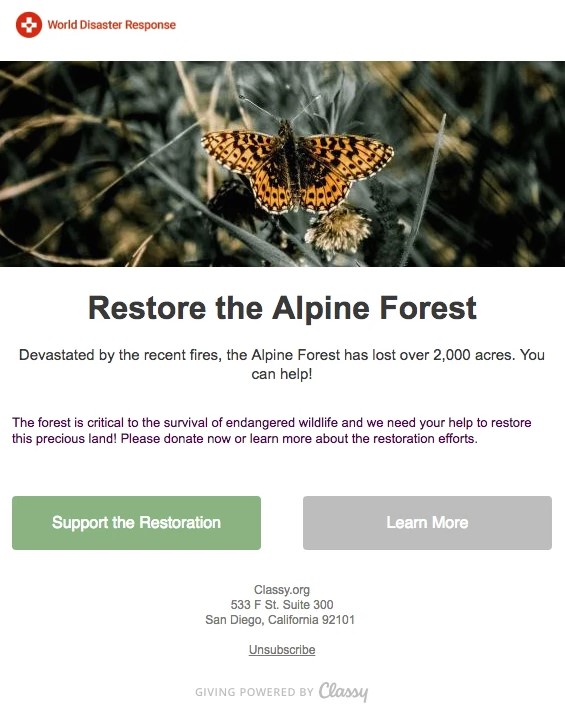
Or, you can both educate and grab your subscriber’s attention by including an infographic within your email. This example from Habitat for Humanity of Florida will shed light on the sort of figures nonprofits can integrate into their marketing campaigns.
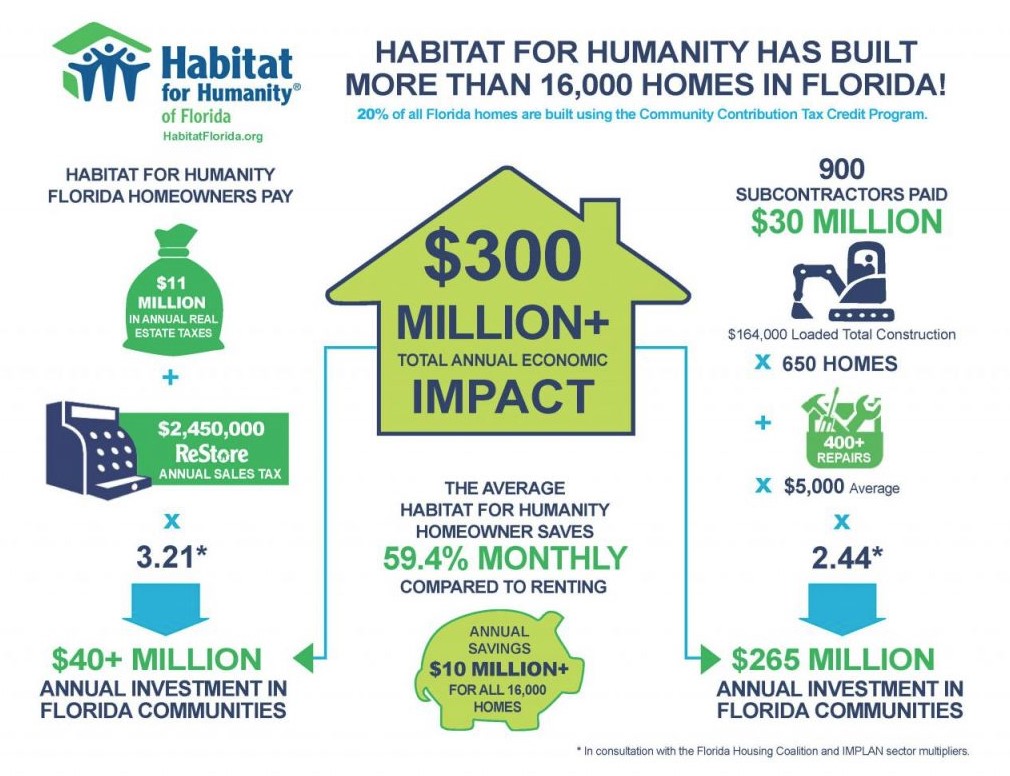
8. Matching donation emails
Donation matches are one of the factors that invite donors to give more. This is especially helpful if they are only able to pledge a small amount. Enabling a donor to double their impact within a particular time frame, for example, can be useful in creating urgency to participate.
Messages like this one below from WE tend to resonate with recipients. The notion of doubling their impact combined with the hopeful copy (“It’s never too late to change the world”) makes this one a winner.
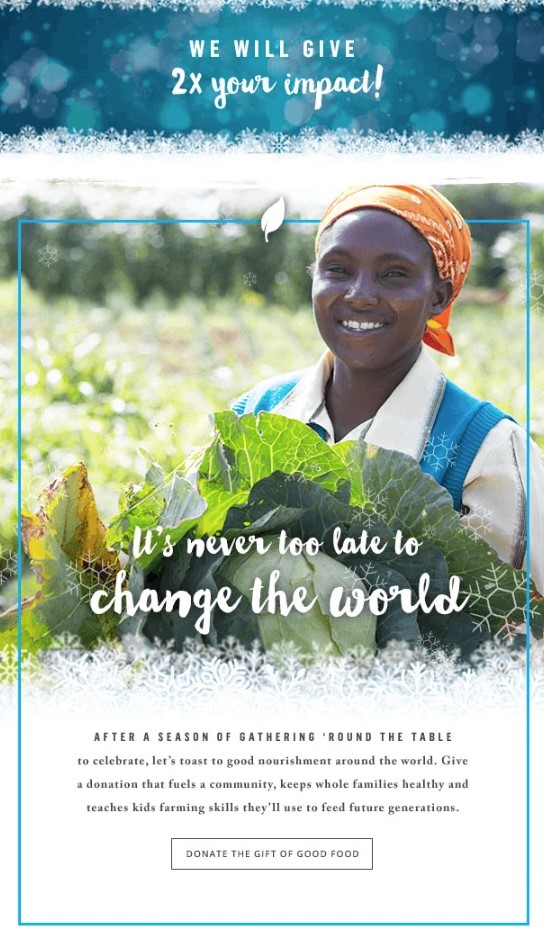
9. Volunteer emails
Volunteer emails are a good way for your supporters to connect with your organization beyond financial transactions. Supporters likely donate as they have a personal connection to your mission. This type of email keeps them informed about opportunities for them to be directly involved in the important work that you do.
You can see an example of a volunteer email from Help for Heroes right below.

You can see the full email right here.
So, what can you learn from this email? Here you are:
-
Include social sharing buttons. Loyal subscribers will never mind sharing your content on LinkedIn, Facebook, or other social media channels.
-
Mention the date. Subscribers should confirm whether they’ll be available on the date for your event.
-
Provide alternative channels of communication. Some people prefer communicating over the phone rather than via email. Therefore, be prepared to get calls from people who need clarification.
-
Monitor the performance of your CTAs. You can include at most 3 CTAs and determine the one that subscribers click the most with a click map. This will allow you to optimize future emails for more conversions.
-
Be credible. Show subscribers updates on previous events to let them know the progress you’re making.
10. Question and survey emails
When you are competing with the likes of social media and chatbots, anything you can do to open up the communication lines and make your email interactive is a major plus.
That is why surveys and question-based messages like this one from WWF are such a smart move:
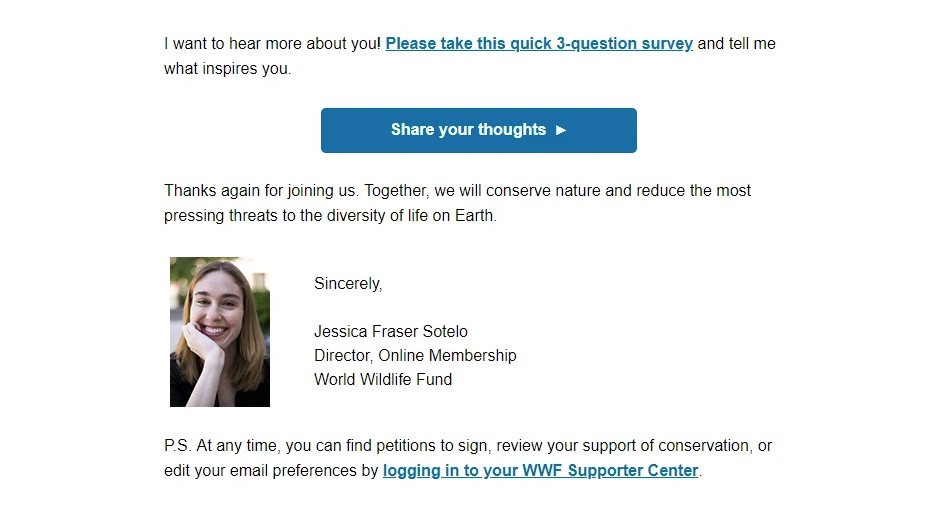
Leading to a detailed questionnaire, these types of emails do double-duty as you learn more about your recipients and better segment your email list.
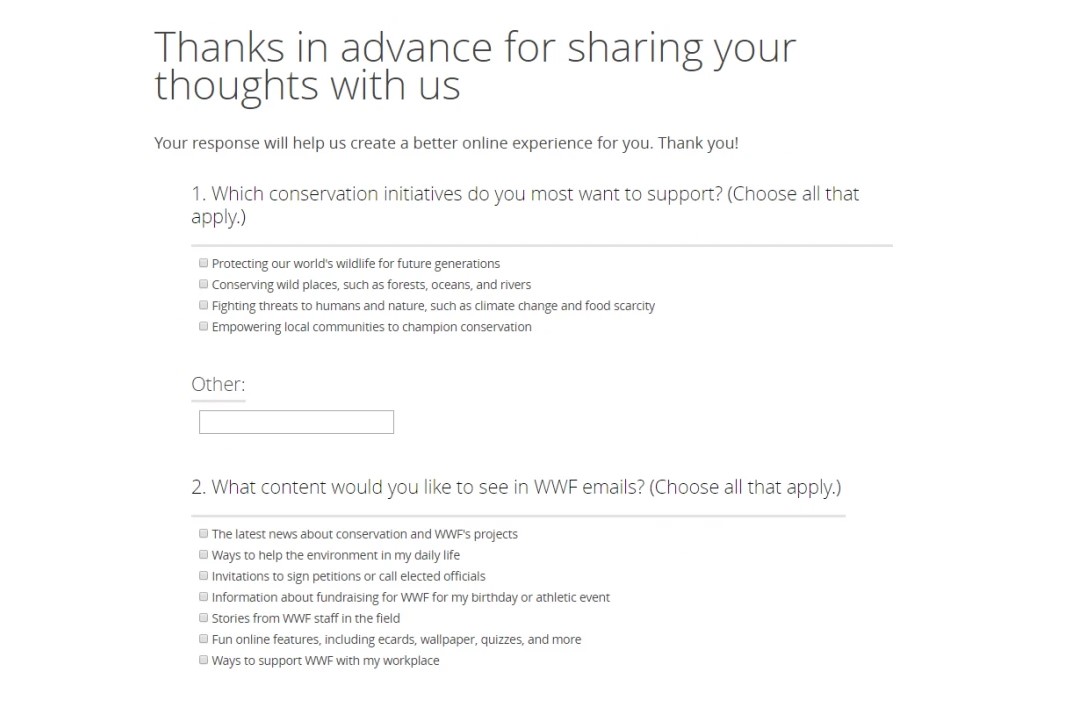
Letting your subscribers know you are listening can help distinguish you from competitors in their inbox who constantly bombard them with offers.
Also, surveys help nonprofits achieve a much-needed sense of personalization for providing the right messaging. By directly surveying your subscribers, you can fine-tune your email marketing campaigns in the future.
11. The minimalist email
In fact, not all emails need to be major productions.
A “less is more” mentality with your nonprofit emails not only requires less legwork on your part, but it is also easier on your subscribers.
Consider that your reader’s time is valuable and the average attention span for adults is 9 secs. With fewer points to drop off or lose your subscribers’ attention, short emails with straightforward copy tend to convert better than lengthier ones. This approach also makes it easier for your subscribers to pay attention to your CTA.
For instance, brief messages like this one from UNICEF really pack a punch with its impressive design and clear CTA.
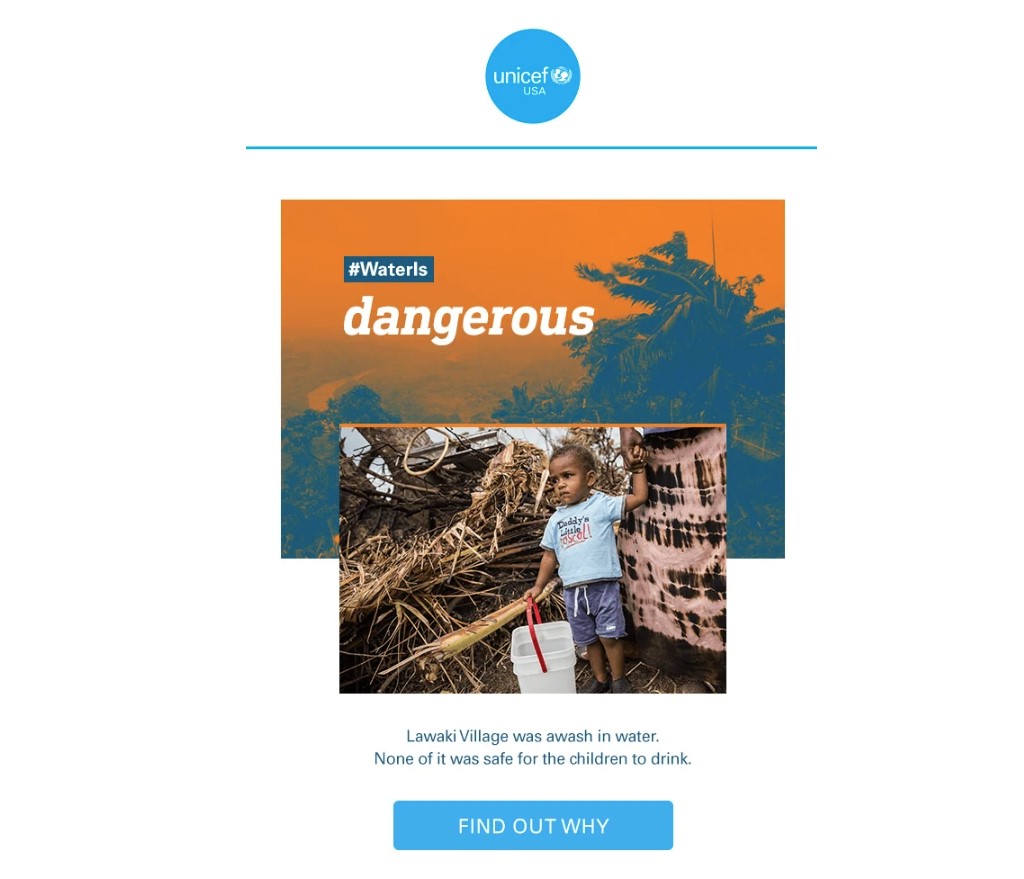
6 email marketing best practices for nonprofits
Email marketing best practices help nonprofits stay on top of their marketing game. In this section, we’ll look at 6 best practices for your reference.
1. Grow your donor base the right way
It should never be challenging to sign up for your nonprofit’s email list. Supporters will be looking for your email list signup form, so ensure to make it easy to find.
There are specific locations that are best for placing your signup forms, such as your website’s footer, pages with the most traffic, your “About Us” page, or even social media channels.
Another great time to collect donor emails is at events. If you have a registration table, merchandise table, or any other kind of kiosk, this is an excellent opportunity to set up an iPad with a signup form.
Partnership opportunities are also great list-building tools. Running email marketing campaigns with other nonprofits - or even for-profits - that are aligned with your organization mission can broaden your reach. Make sure whatever list-building campaign you’re running is GDPR and CAN-SPAM compliant.
Several more quick tips on growing your donor base and subscriber list the right way include:
-
Get permission. A double opt-in is an excellent way to make sure you have a quality list interested in your content.
-
Aim for quality over quantity. It is better to have a small list of genuine supporters than to have a large list that is vaguely aware of your cause. While it is easy to focus on list size, list quality is what really matters.
-
Keep your signup forms simple and short. When collecting email addresses through signup forms, make sure that it is a simple process. If a supporter has to fill out several boxes just to join your email list, they’re more likely to give up before donating anything.
2. Personalize and segment your mailing list

Nonprofits often use personalization and segmentation to break through the noise and drive more donations. An Accenture survey found that 44% of donors are willing to contribute 10% more for a personalized experience.
To collect valuable data, you can:
- Ask your subscribers why they joined your mailing list
- Use surveys to know the type of content they want to receive
- Learn about their particular interests by tracking the links they are clicking
Segmentation involves categorizing recipients based on their demographics and interests. It is reasonable to invite the subscribers of the US to your list if you are hosting an event in this region, assuming your list is segmented according to the location.
Below are some popular criteria for segmenting your mailing list:
-
Opt-ins used. Did your honors use a subscription form or lead magnet? Tailor your email content to the lead magnet that they used to join your list.
-
Volunteers and donors. Make a segment for anyone who attends your events and give donations regularly.
-
Frequency of donations. Track the subscribers that donate weekly, bi-weekly, monthly, or annually, and segment them to project your revenue.
-
Contribution amounts. Note the amount of money that your donors contribute, for instance, from $10 to $1,000, from $1,001 to $5,000, and from $5,000 to $10,000.
Related topics:
3. Commit to regular sends
Regular email marketing is one of the most effective ways to grow your nonprofit organization. A schedule for your emails can keep you on top of them so you can steadily grow your donor base.
Making email sends an “always on” part of your marketing strategy will play a significant role in your success on the channel. That doesn’t mean you’re bombarding your email list with constant messages; it means you’re committed to consistency in how often you send your emails.
How often nonprofits should send email marketing campaigns is still a hotly debated topic. Experts recommend doing regular testing to find the right number of emails that work for your organization. Also, you can run surveys to understand more about how often donors want to receive your emails.
NOTE: What works for well-known nonprofits may not work for you. So, study the sending patterns of successful nonprofits, compare, and contrast them with yours.
Related topic: When is The Best Time to Send Marketing Emails?
4. Never focus on donations alone
It is okay to request subscribers to contribute. Nevertheless, it is wrong to bombard them with donation requests often.
The worst you can do is to ask for donations in the first email. Instead, send them a friendly welcome email and thank everyone for joining your email list. Next, build trust with them by creating content that makes them expect to read your future emails.
You can:
- Give them updates on the projects you are working on
- Be transparent and send them monthly donation reports, as well as how you use the funds
- Share case studies
- Send them thank-you notes
- Give them gifts or coupons to redeem.
Read our previous section to know more types of nonprofit emails.
5. Clean your mailing list regularly

You don’t really need a huge list of donors, especially when your email delivery and open rates are low.
Many subscribers can change and abandon their email addresses. Having invalid email addresses can reduce your deliverability, open rate, and sender score.
So, track the number of subscribers who haven’t engaged with your emails for a specific period (i.e., the last five to six months) and try to re-engage them. Send emails to ask them whether they still want to hear from your organization or not. If they don’t take action, notify them that you will remove them from your list.
Read more: Email Marketing List Management Explained (with 8 Best Practices)
6. Test, analyze, and adapt accordingly
Last but not least, running a nonprofit email program is not a “one and done” marketing strategy. You can’t just set it up and keep doing the same thing.
It requires you to take note of KPIs (Key Performance Indicators) and make changes to your approach periodically based on those factors.
While industry benchmarks may be a useful starting point of comparison when you are just beginning to flesh out your email strategy, keep in mind that not all NPOs are the same, and not all NPO audiences are going to respond the same way to emails.
So, to start, keep track of a few key email metrics, measure them with each email sent, then look for trends over time.
3 best tools for nonprofit email marketing
Choosing a solid platform to maximize your nonprofit email marketing potential is essential. So, below we’ve put together a list of 3 best email marketing tools, which can offer great benefits for nonprofits.
1. AVADA Email Marketing
If you are looking for a reasonable and outstanding solution for your nonprofit, AVADA Email Marketing should be your very first candidate.
With an intuitive and user-friendly interface, the platform is simple to use for even novice users. Plus, if you have no ideas on designing your nonprofit emails, AVADA Email Marketing offers ready-to-use email templates that can save a significant amount of time and effort for you. More than just collect email addresses, its sign-up forms allow your nonprofit to deliver promo and useful content or updates. You can take advantage of:
- Newsletter popup
- Spin-to-win
- Inline form
Moreover, the platform makes it easy to target and segment your donors, so that you can get the best possible results for your email marketing campaigns. Noticeably, the app offers a free plan and a 14-day free trial for you to experience, so test it out today!
2. Zoho Campaigns
It’s essential to get to know your donor base, to make sure that you have up-to-date details to contact them in a timely fashion, and to make sure all interactions are stored in one place.
Zoho Campaigns offers a set of contact management features that make it appropriate for nonprofits. The tool allows you to add custom fields to your sign-up forms and contact management functionality to ensure that you record the specific information relevant to managing your donors.
This tool also brings together all supporter information and interactions with your organization into one place. The information that can be added to this contact management hub is entirely customizable, but some helpful details include:
- Email segments and lists on which they’re included
- Campaigns they have been sent
- Updates to their contact details
- Activities on social media
3. Campaign Monitor
Keeping track of how your email campaigns perform is vital, as it lets you know which ones are effective, which ones need improving, and which aspects can be optimized to improve ROI.
Campaign Monitor enables you to download add-ons that can be used to extend the email marketing solution’s capabilities. That way, you can track donations through CRM (Customer Relationship Management) solutions, such as Salesforce and Microsoft Dynamics CRM. Ultimately, you can see which campaigns have led to donations.
The bottom line
And that’s it! With these basics in mind, you are ready to begin the process of building and executing your nonprofit email marketing campaign.
This is, of course, just the beginning. However, it doesn’t have to be overwhelming - you might simply need a strategic partner by your side. Contact us to start a conversation about effective and strategic email marketing for your nonprofit, and to set your organization on the path of email (and digital) marketing success.
New Posts






